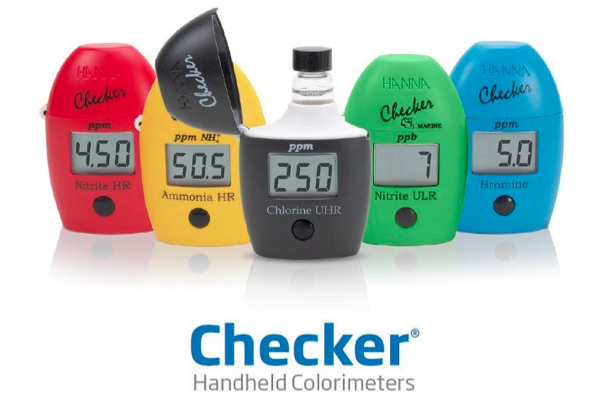
Hanna has just announced an update to their “Checker” line of colorimeters. For those that are not familiar with these devices, they are like a test kit on steroids. The chemical process (i.e. what you add to the water sample) is similar, but the key difference is that the device reads the sample for you. Basically the device can measure very discrete ranges of color changes, unlike the human eye which doesn’t do a good job of differentiation between shading (and perfect for people who are somewhat colorblind). Those little color strips you always have trouble reading next to the water vial? Those are garbage and if you look carefully you’ll see that the specificity of the different colors does not give a very accurate test result. Enter the colorimeter which measures the color automatically. While a bit pricey, these devices are used by expert level hobbyists, and these new models are on the cheap side compared to their professional counterparts. The use of a colorimeter allows for measurement of trace elements in the range of low PPM to Parts Per Trillion (PPT), which is key when measuring things like Phosphate, or something we don’t typically test for like Bromine. If you are interested in a higher level of accuracy in your testing, check out the new additions to the Hanna line HERE.










“Those little color strips you always have trouble reading next to the water vial? Those are garbage and if you look carefully you’ll see that the specificity of the different colors does not give a very accurate test result.”
I would argue differently – that they’re not garbage. Test strips and test solutions that one has to pair up visually with a given color block are a semiquantiative test. These Hanna Checkers are in a different class as they are a low-end spectrophotometer yielding much more exact numbers that reefkeepers want – and they take out the subjectivity of a visual reading.
Test strips / titrations work well depending on the application, how well the company does with matching the solution color to a given Pantone color block, how stringent the company’s QC is per batch of reagents, and whether or not the end user is color blind to a given color range. Some people are very poor at discerning color transitions of red and green (~5% of males), and blue and yellow. This color perception problem is inherently problematic as many of the test strips / titration tests use a yellow to blue transition which at its mid-point is a greenish color. Others use different shades of blue or red/purple. While it is easy to say “Use a different color transition then!” a lot of times it’s not that easy. Due to analyte requirements, there are only certain chemicals that will react appropriately and, unfortunately, limit options. Also, QC personnel typically are tested for color perception problems and those that do have a problem with a certain range do not participate in passing/failing a given product (or at least should not). At two of my jobs, I’ve had to undergo color perception tests and fortunately came away knowing that I have almost 100% color perception (whew!). Wikipedia has a really good article on color blindness: http://en.wikipedia.org/wiki/Color_blindness
I’ve seen a LOT of test strips sold in stores that have passed their expiration date or have no expiration date printed on the bottle anywhere. These things expire, folks, and can potentially shift away from their color blocks. Those that are within expiration date a lot of times don’t match their respective color blocks due to poor QC or wide QC acceptance criteria, which give test strips a bad name.
My opinion is that test strips / titration tests are good so long as a quality test is used and the end user keeps in mind the limitations of said test and that they’re not color blind to said color transition.